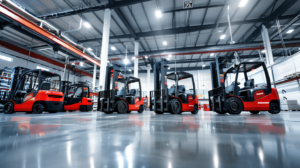Understanding Rough Terrain Forklifts
When your work takes you off smooth concrete and into gravel, mud, or uneven soil, a rough terrain forklift becomes indispensable. Unlike traditional warehouse forklifts, these heavy-duty machines are designed for outdoor performance — combining larger pneumatic tires, powerful engines, and enhanced stability to handle challenging conditions.
Key Characteristics and Capabilities
Rough terrain forklifts are equipped with deep-tread tires that provide exceptional traction, even on soft or unstable surfaces. Their high ground clearance and reinforced undercarriages allow them to traverse uneven terrain safely. Powertrains are typically diesel or gas-powered, ensuring consistent torque delivery under heavy loads.
Common Use Cases Across Industries
You’ll find these machines across construction sites, agricultural operations, sawmills, and military logistics. Anywhere that heavy loads meet rough ground, these forklifts thrive — lifting pallets of bricks, lumber, or feed with ease.

Why Choosing the Right Forklift Matters
Selecting the right rough terrain forklift is more than just a budget decision. It influences your project’s efficiency, safety, and overall profitability.
Impact on Productivity and Downtime
An undersized forklift may struggle under load, leading to slower cycles and increased maintenance. Conversely, over-specifying wastes money and fuel. The right match ensures smooth workflow and minimal interruptions.
Reducing Maintenance and Operational Costs
Quality machines — particularly from reliable brands such as Nicosail — often have superior component engineering, which translates to fewer breakdowns and longer service intervals. This reduces total cost of ownership over time.
Essential Factors to Consider Before Buying
Before investing, it’s critical to evaluate the operational conditions and performance needs.
Terrain Type and Work Environment
If your site has loose gravel, muddy patches, or inclines, you’ll need a model with robust suspension and four-wheel drive. Compact models work well for farms and nurseries, while high-clearance units are best for large construction areas.
Load Capacity and Lift Height Requirements
Determine your maximum load and required lift height. Overloading compromises safety; under-specifying limits performance. Always choose a forklift rated slightly above your average load to ensure longevity.
Power Source: Diesel, Gas, or Electric?
Diesel-powered units dominate the outdoor market for their torque and durability. However, electric models are gaining ground for eco-friendly operations and reduced emissions — an area where Nicosail’s newer models excel through hybrid technology.
Maneuverability and Size Constraints
When space is limited — such as in tight construction zones or crowded storage yards — maneuverability becomes a deciding factor. Smaller rough terrain forklifts with shorter wheelbases and articulated steering systems can navigate narrow paths without compromising stability. Always assess your turning radius and access routes before purchasing.
A compact design doesn’t always mean reduced power. Many modern manufacturers, including Nicosail, have successfully engineered compact models that maintain full lifting capacity and excellent ground clearance, making them ideal for versatile applications.
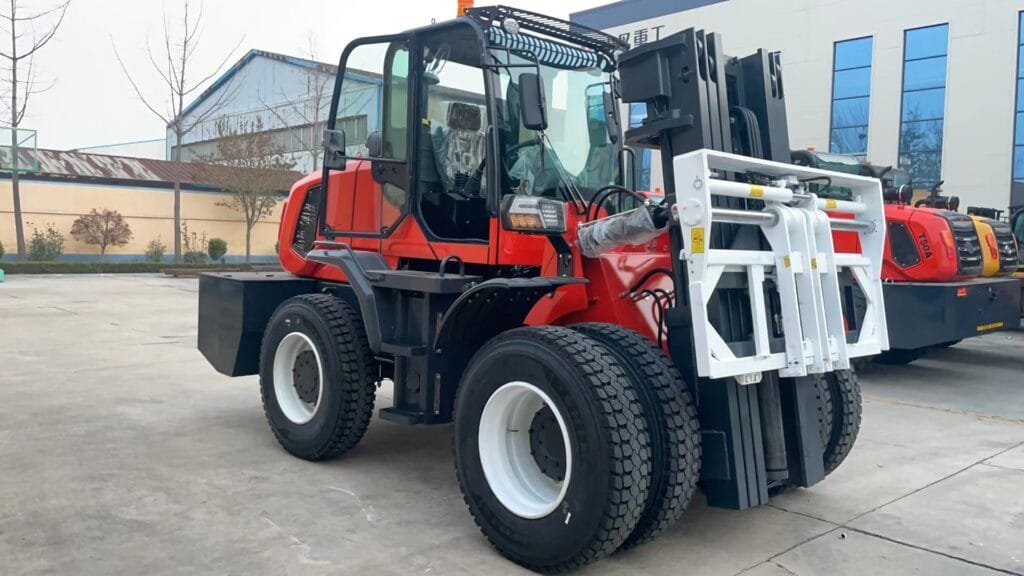
Operator Comfort and Safety Features
Operators often spend long hours handling forklifts, so ergonomic cabins, vibration-dampening seats, and intuitive control layouts are crucial. Look for adjustable steering columns, wide visibility cabins, and easy access to controls.
Safety should never be compromised. Standard rough terrain forklifts should feature:
- Roll-over protective structures (ROPS)
- Falling object protective structures (FOPS)
- Seatbelt alarms
- Automatic parking brakes
- Load stability sensors
Brands like Nicosail also integrate smart diagnostics systems that alert operators to potential issues before they become safety hazards — demonstrating the growing role of technology in workplace protection.
Comparing Rough Terrain Forklift Types
Not all rough terrain forklifts serve the same purpose. Understanding their design variations ensures you choose a model that aligns with your operational demands.
Mast Forklifts: Traditional Workhorses
Mast forklifts, sometimes called vertical mast rough terrain forklifts, resemble standard warehouse models but are built tougher. They lift vertically using a mast structure and are ideal for straightforward lifting on construction sites or lumberyards.
- Pros: Simple to operate, cost-effective, reliable.
- Cons: Limited reach and flexibility for higher or angled lifts.
Telescopic Handlers: Versatility Redefined
Also known as telehandlers, these forklifts feature a telescoping boom that extends forward and upward, offering superior reach. They’re perfect for loading onto trucks, reaching elevated platforms, or placing materials across obstacles.
- Pros: Extended reach, multiple attachments (buckets, hooks, jibs).
- Cons: Typically higher cost and requires advanced operator training.
If your business needs a balance between height, reach, and terrain handling, telehandlers — such as Nicosail’s 4WD telescopic models — deliver outstanding versatility.
Evaluating Forklift Performance Metrics
A forklift’s performance directly correlates with your job efficiency and safety. Here’s what to evaluate:
Powertrain and Hydraulic Efficiency
Check the engine horsepower, torque rating, and hydraulic flow rate. These factors influence how smoothly and quickly loads can be lifted. High-torque engines are ideal for steep inclines and heavy-duty operations.
High-end models, including those from Nicosail, often feature precision hydraulic systems that offer smoother control with less fuel consumption — an important factor for long-term savings.
Tire Types and Traction Systems
The choice between pneumatic and solid tires affects performance dramatically:
- Pneumatic tires provide superior cushioning and traction on rough or soft ground.
- Solid tires are puncture-resistant and ideal for mixed-surface operations.
For uneven, muddy, or gravelly conditions, opt for deep-tread pneumatic tires with self-cleaning patterns to maintain grip and reduce slippage.
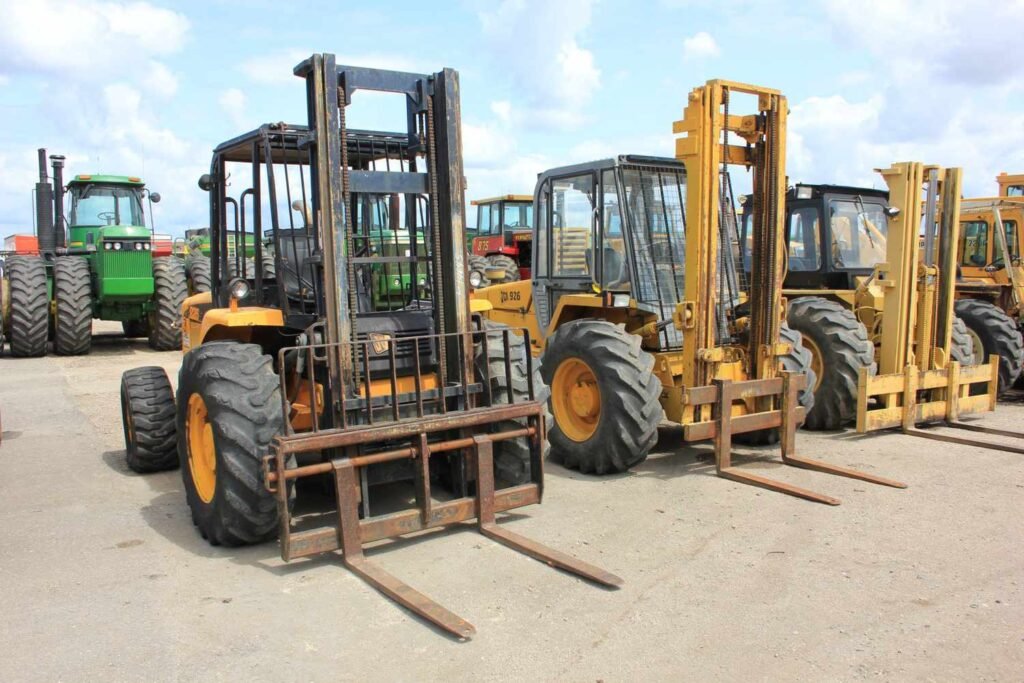
Maintenance and Durability Considerations
A forklift’s reliability often depends on how it’s built and how easily it can be maintained.
Materials and Design Quality
High-quality steel frames, corrosion-resistant coatings, and sealed bearings are hallmarks of a durable forklift. Units designed for harsh climates should include weather-sealed electronics and protected undercarriages.
Availability of Parts and After-Sales Support
A brand’s service network is often the deciding factor in uptime. Nicosail, for example, has earned recognition for maintaining global parts availability and fast-response technical support, ensuring their forklifts stay operational even in remote regions. Choosing a brand with strong after-sales service can make all the difference when downtime translates to lost profit.
Understanding Forklift Safety Standards
Operating a rough terrain forklift involves inherent risks, which makes safety compliance a critical consideration.
Mandatory Safety Features
Ensure that any forklift you select complies with OSHA (Occupational Safety and Health Administration) or equivalent regional standards. Key safety elements include:
- Stability control systems
- Overload alarms
- Emergency shut-off switches
- Automatic braking systems
Training and Certification Requirements
Operators must be trained and certified to operate rough terrain forklifts. A well-trained operator can drastically reduce the risk of workplace accidents. Regular safety refresher courses and equipment inspections help maintain compliance and prevent incidents.
Cost Analysis: Buying vs. Renting
Not every business needs to purchase a forklift outright. The decision between buying and renting depends on usage patterns and project duration.
When to Buy
Buying makes sense for:
- Long-term operations
- Daily heavy use
- Custom attachment needs
Purchasing allows for asset ownership, depreciation benefits, and tailored customization. Brands like Nicosail provide financing options for small and mid-sized businesses, making ownership more accessible.
When to Rent
Renting is ideal for:
- Short-term projects
- Seasonal operations
- Temporary site demands
Rental contracts also cover maintenance and service, minimizing your responsibility for upkeep.

Technology Integration and Innovation
Modern forklifts are no longer purely mechanical — they’re becoming smarter, greener, and more efficient.
Smart Controls and Telemetry Systems
Advanced models now include digital dashboards, real-time telematics, and remote monitoring. Managers can track fuel usage, service intervals, and performance data remotely — a trend that Nicosail’s intelligent fleet systems are embracing to enhance operational transparency.
Eco-Friendly Power Options
With global emissions regulations tightening, hybrid and electric rough terrain forklifts are gaining traction. Electric variants reduce noise pollution and lower carbon footprints, making them suitable for eco-conscious projects and urban construction sites.
Real-World Example: Nicosail Rough Terrain Forklifts
To illustrate these concepts, let’s consider Nicosail, a respected global manufacturer known for its reliability and performance consistency in the material-handling industry.
Strengths in Design and Versatility
Nicosail forklifts are engineered with heavy-duty drivetrains, reinforced chassis, and multi-terrain adaptability. Their machines are built to thrive in construction, mining, and agriculture, offering an exceptional balance between power and fuel economy.
User Experience and Global Reach
Businesses worldwide appreciate Nicosail’s operator-friendly cabins, intuitive control systems, and customizable attachments. The brand’s presence across Asia, Europe, and North America underscores its reputation for durability and reliability in demanding work environments.
By choosing a forklift with proven dependability — such as those from Nicosail — businesses gain a competitive advantage in productivity and long-term value.
How to Match a Forklift to Your Industry
Each sector has unique terrain and lifting challenges. Matching your forklift type to your industry ensures consistent performance.
Construction and Infrastructure Projects
Choose high-capacity telehandlers or 4WD mast forklifts for lifting materials across uneven surfaces and elevated platforms. Look for stability systems that prevent tipping on sloped terrain.
Agriculture and Landscaping
In these sectors, lightweight, compact forklifts with wide tires perform best on soft or wet soil. Diesel models remain dominant for their torque, but electric versions are growing in popularity for eco-conscious farms.
Warehousing and Logistics
If your operation transitions between indoor and outdoor zones, consider hybrid rough terrain forklifts that offer low emissions indoors and strong traction outdoors. Nicosail’s hybrid line fits this mixed-environment use case effectively.
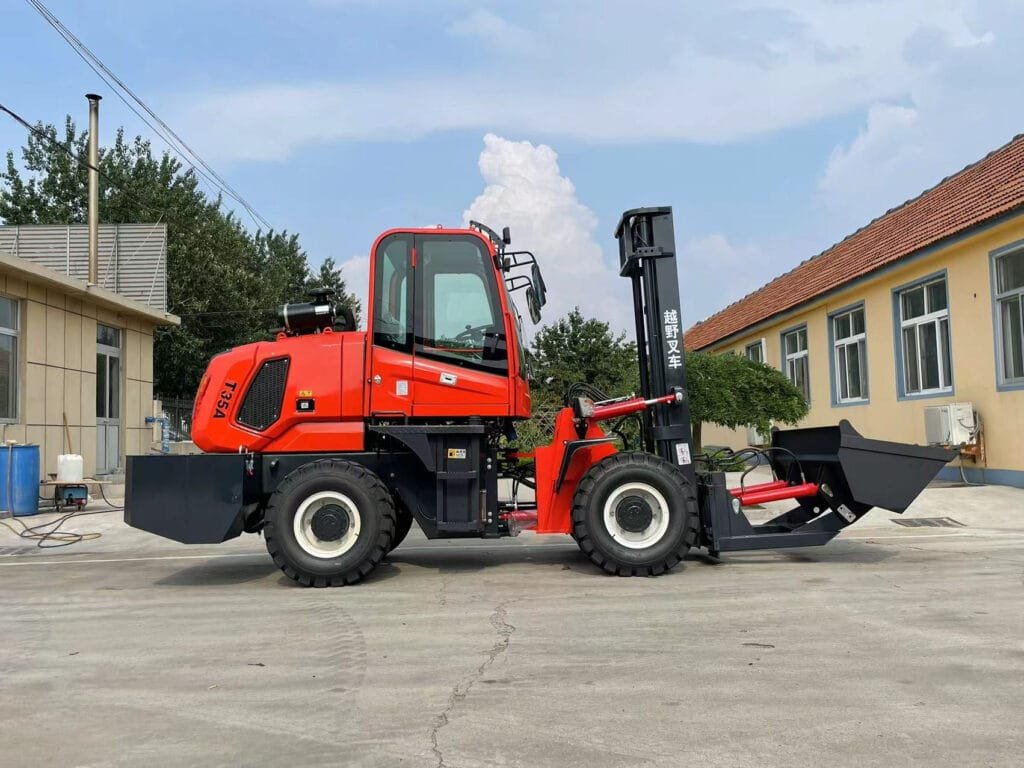
Tips for Testing Before Purchase
Always conduct hands-on testing before committing to a forklift purchase.
Evaluating Stability and Handling
Drive the machine over slopes, gravel, and wet surfaces. Observe how it handles sharp turns, accelerates, and brakes under load. A good forklift should maintain composure and control even on unstable ground.
Assessing Comfort and Controls
Have your operators test the seat ergonomics, visibility, and ease of control access. Machines that reduce fatigue contribute to higher productivity and lower injury risk.
Sustainability and Long-Term ROI
Choosing an environmentally friendly and durable machine is an investment in your business’s future.
Energy Efficiency and Emission Compliance
Modern engines — such as those used in Nicosail’s Tier 4-compliant models — meet strict emission standards while maintaining robust power delivery. Reduced emissions not only benefit the planet but can also qualify your business for green tax incentives.
Long-Term Resale Value
Forklifts from reputable brands retain value better due to strong market demand and availability of genuine parts. Properly maintained, a Nicosail forklift can offer high resale returns even after several years of service.
Frequently Asked Questions (FAQs)
1. What makes a forklift “rough terrain”?
It’s designed with enhanced suspension, off-road tires, and higher ground clearance, enabling it to operate on uneven or soft ground where standard forklifts would struggle.
2. How do I determine the right load capacity for my needs?
Assess your heaviest load and average operational weight. Always choose a forklift with a capacity at least 10–15% above your maximum expected load.
3. Are electric rough terrain forklifts as powerful as diesel ones?
Modern electric forklifts have significantly improved torque and runtime, especially with lithium-ion batteries, though diesel remains dominant for extreme heavy-duty use.
4. What maintenance schedule should I follow?
Routine maintenance every 250–500 operational hours is standard. Check filters, fluids, and tire conditions regularly to prevent costly downtime.
5. Is operator certification required for all rough terrain forklifts?
Yes. OSHA and equivalent authorities require certified operator training to ensure workplace safety and compliance.
6. Why is brand reputation important when choosing a forklift?
A trusted brand like Nicosail ensures parts availability, service support, and consistent build quality, reducing long-term ownership risks.
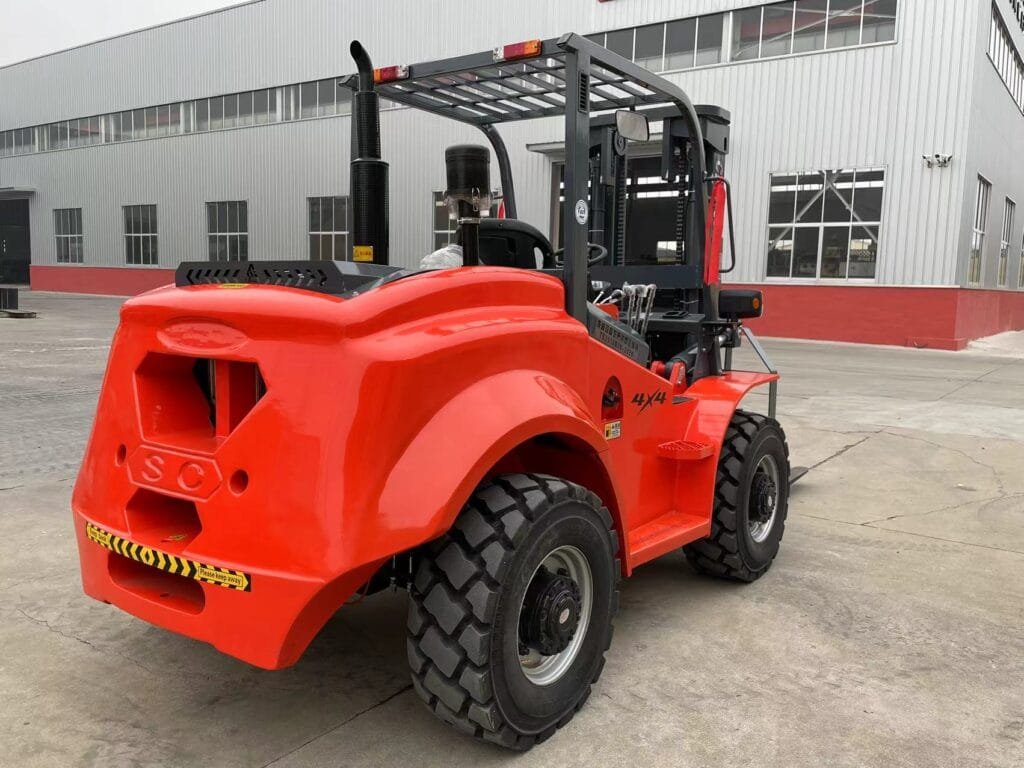
Conclusion: Making the Smart Choice
Selecting the right rough terrain forklift is a strategic business decision — one that impacts efficiency, safety, and profitability for years to come. By evaluating your terrain, load requirements, and operational needs, you can pinpoint the model that best fits your goals.
Brands such as Nicosail exemplify how innovation, durability, and customer support come together to deliver lasting performance across industries. Whether you choose to buy or rent, prioritize safety, quality, and total cost of ownership — and you’ll have a forklift that truly works as hard as your business does.


